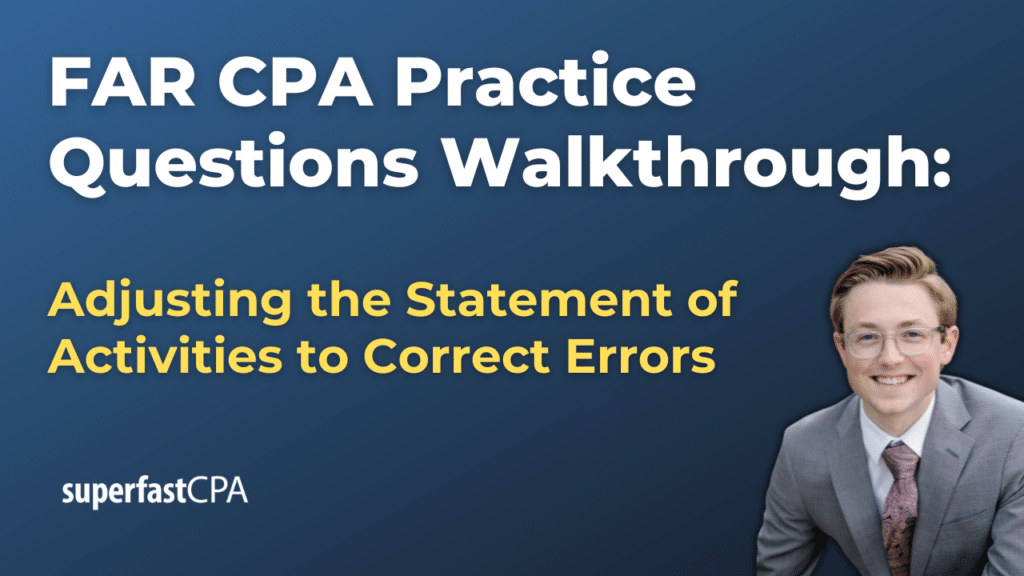In this video, we walk through 5 FAR practice questions teaching about adjusting the statement of activities to correct errors. These questions are from FAR content area 1 on the AICPA CPA exam blueprints: Financial Reporting.
The best way to use this video is to pause each time we get to a new question in the video, and then make your own attempt at the question before watching us go through it.
Also be sure to watch one of our free webinars on the 6 “key ingredients” to an extremely effective & efficient CPA study process here…
Adjusting the Statement of Activities
The statement of activities is a key financial document for nongovernmental, not-for-profit entities. It provides a detailed overview of the organization’s revenue, expenses, and changes in net assets during a specific period. As a CPA exam candidate, understanding how to adjust this statement correctly is crucial for ensuring that financial statements accurately reflect the organization’s financial position.
Understanding the Basics
The statement of activities categorizes revenue and expenses into two main classes of net assets: with donor restrictions and without donor restrictions. Revenue and support are recorded based on the type of restriction imposed by donors, while expenses are typically classified as program expenses, management and general expenses, or fundraising expenses.
All expenses, except investment-related expenses, should be classified as without donor restrictions, regardless of the restrictions on the revenue that funded them. When expenses are related to donor-restricted contributions, an equivalent amount should be released from net assets with donor restrictions.
Common Errors and Adjustments
One of the most common errors in the statement of activities involves the incorrect classification of expenses. Below are some examples and how to adjust for them:
Example 1: Misclassification of Donor-Restricted Expenses
Suppose an organization receives a $200,000 donation restricted for a capital project. During the year, it spends $150,000 on this project and records this expense under net assets with donor restrictions. This is incorrect. The $150,000 should be recorded as an expense without donor restrictions, and an equivalent amount should be released from net assets with donor restrictions.
Adjustment: Reclassify the $150,000 expense to net assets without donor restrictions and release $150,000 from net assets with donor restrictions. This ensures the net assets with donor restrictions reflect only the unspent restricted funds.
Example 2: Incorrect Classification of Quasi-Endowments
A board of directors decides to set aside $100,000 for a future scholarship program and mistakenly classifies this amount under net assets with donor restrictions. This is an error because only donor-imposed restrictions should be classified as such.
Adjustment: Reclassify the $100,000 from net assets with donor restrictions to net assets without donor restrictions, as it is a board-designated fund (quasi-endowment), not a donor-restricted one.
Example 3: Inaccurate Expense Categorization
Consider an organization that records all its expenses under management and general, including $80,000 for program coordinators’ salaries and $40,000 for fundraising event costs. This misclassification can significantly distort the financial statements.
Adjustment: Reclassify the $80,000 to program expenses and the $40,000 to fundraising expenses. Accurate classification provides a clearer picture of how the organization’s resources are being used to fulfill its mission.
Conclusion
For CPA exam candidates, mastering the adjustments to the statement of activities is essential. Understanding the correct classification of expenses, the appropriate treatment of quasi-endowments, and the accurate reclassification of net assets will help ensure that not-for-profit financial statements provide a true and fair view of the organization’s financial health.
In practice, these adjustments help maintain transparency and accountability, crucial for the stakeholders of not-for-profit organizations. Properly adjusting the statement of activities not only ensures compliance with accounting standards but also enhances the credibility and reliability of the financial information presented.













